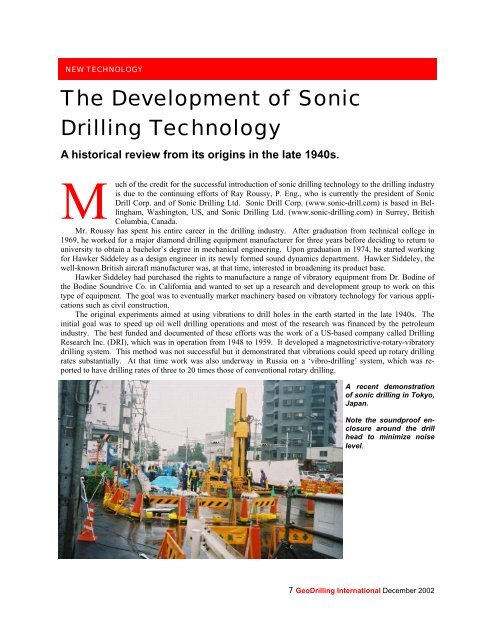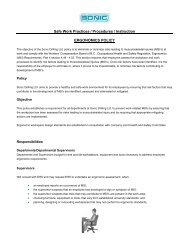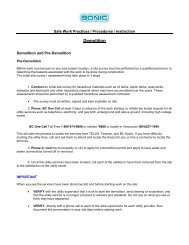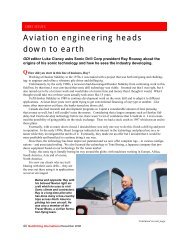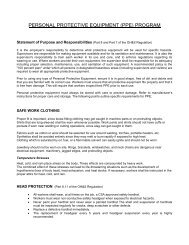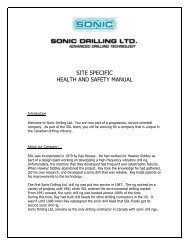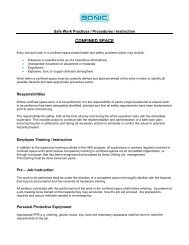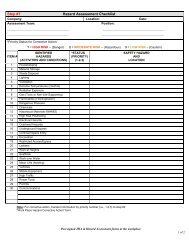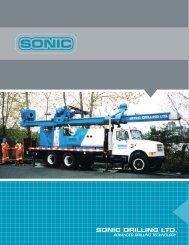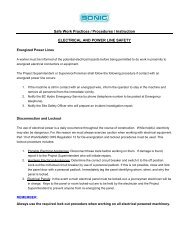The development of Sonic Drilling Technology - Sonic Drilling Ltd.
The development of Sonic Drilling Technology - Sonic Drilling Ltd.
The development of Sonic Drilling Technology - Sonic Drilling Ltd.
Create successful ePaper yourself
Turn your PDF publications into a flip-book with our unique Google optimized e-Paper software.
NEW TECHNOLOGY<br />
<strong>The</strong> Development <strong>of</strong> <strong>Sonic</strong><br />
<strong>Drilling</strong> <strong>Technology</strong><br />
A historical review from its origins in the late 1940s.<br />
M<br />
uch <strong>of</strong> the credit for the successful introduction <strong>of</strong> sonic drilling technology to the drilling industry<br />
is due to the continuing efforts <strong>of</strong> Ray Roussy, P. Eng., who is currently the president <strong>of</strong> <strong>Sonic</strong><br />
Drill Corp. and <strong>of</strong> <strong>Sonic</strong> <strong>Drilling</strong> <strong>Ltd</strong>. <strong>Sonic</strong> Drill Corp. (www.sonic-drill.com) is based in Bellingham,<br />
Washington, US, and <strong>Sonic</strong> <strong>Drilling</strong> <strong>Ltd</strong>. (www.sonic-drilling.com) in Surrey, British<br />
Columbia, Canada.<br />
Mr. Roussy has spent his entire career in the drilling industry. After graduation from technical college in<br />
1969, he worked for a major diamond drilling equipment manufacturer for three years before deciding to return to<br />
university to obtain a bachelor’s degree in mechanical engineering. Upon graduation in 1974, he started working<br />
for Hawker Siddeley as a design engineer in its newly formed sound dynamics department. Hawker Siddeley, the<br />
well-known British aircraft manufacturer was, at that time, interested in broadening its product base.<br />
Hawker Siddeley had purchased the rights to manufacture a range <strong>of</strong> vibratory equipment from Dr. Bodine <strong>of</strong><br />
the Bodine Soundrive Co. in California and wanted to set up a research and <strong>development</strong> group to work on this<br />
type <strong>of</strong> equipment. <strong>The</strong> goal was to eventually market machinery based on vibratory technology for various applications<br />
such as civil construction.<br />
<strong>The</strong> original experiments aimed at using vibrations to drill holes in the earth started in the late 1940s. <strong>The</strong><br />
initial goal was to speed up oil well drilling operations and most <strong>of</strong> the research was financed by the petroleum<br />
industry. <strong>The</strong> best funded and documented <strong>of</strong> these efforts was the work <strong>of</strong> a US-based company called <strong>Drilling</strong><br />
Research Inc. (DRI), which was in operation from 1948 to 1959. It developed a magnetostrictive-rotary-vibratory<br />
drilling system. This method was not successful but it demonstrated that vibrations could speed up rotary drilling<br />
rates substantially. At that time work was also underway in Russia on a ‘vibro-drilling’ system, which was reported<br />
to have drilling rates <strong>of</strong> three to 20 times those <strong>of</strong> conventional rotary drilling.<br />
A recent demonstration<br />
<strong>of</strong> sonic drilling in Tokyo,<br />
Japan.<br />
Note the soundpro<strong>of</strong> enclosure<br />
around the drill<br />
head to minimize noise<br />
level.<br />
7 Geo<strong>Drilling</strong> International December 2002
NEW TECHNOLOGY<br />
Early Work<br />
During this early period, Dr. Bodine worked with Borg Warner on a down-hole vibrator, which he called a<br />
‘sonic drill.’ It failed because excessive vibratory energy caused mechanical failure <strong>of</strong> the down-hole components.<br />
Later on in the 1960s, Dr. Bodine developed a much larger top-hole vibrator with the support <strong>of</strong> the Shell Oil Co.<br />
<strong>The</strong> machine was intended to be used for oil well service work such as pulling stuck casing and rehabilitating oil<br />
wells. Bodine received many patents in the 1960s for his work.<br />
His large vibrator had a capacity <strong>of</strong> up to 1,000 hp but suffered from poor reliability. It was tested extensively<br />
as a possible high-speed pile driver. Bodine’s group had also started to develop a smaller oscillator when his<br />
equipment was sold to Hawker Siddeley in the early 1970s.<br />
When Hawker Siddeley first looked at this equipment, it was rapidly realized that the funds required to develop<br />
a reliable high horsepower vibrator for pile driving would be prohibitive, considering the small volume <strong>of</strong><br />
machines that could eventually be sold. <strong>The</strong> advent <strong>of</strong> the modern diesel pile driver hammer also discouraged any<br />
further <strong>development</strong> <strong>of</strong> the high frequency vibratory pile driver.<br />
Ray Roussy and his associates then decided to try to see if the smaller vibrator could be used for drilling purposes.<br />
A basic drill rig was designed and constructed in a hurry as a major oil company wanted to see if this vibratory<br />
machine could be used as a seismic drill. <strong>The</strong> oil firm had an urgent requirement to place blasting charges in<br />
some 150 ft. <strong>of</strong> wet clay and sand beneath frozen lakes in the Arctic. <strong>The</strong> machine proved successful in this application<br />
and a few rigs were then built to work in this field for a few years. Major oil and gas discoveries were made<br />
in the Mackenzie Delta at that time, but this activity came to an end in 1977 as a result <strong>of</strong> a 10-year moratorium<br />
imposed on oil and gas <strong>development</strong> in the Arctic.<br />
Interestingly enough, this activity has resumed recently as a pipeline is currently being contemplated to bring<br />
oil and natural gas from Alaska and the Mackenzie Delta to markets in Canada and the US. <strong>The</strong> US now wants to<br />
become more energy self-reliance and <strong>Sonic</strong> <strong>Drilling</strong> <strong>Ltd</strong>. resumed sonic drilling again at this very same location in<br />
the winter <strong>of</strong> 2001/2002, some 26 years later.<br />
<strong>The</strong> early rotary-vibratory drills, or ‘sonic drills’ as they were called, were not configured specifically as drill<br />
heads. <strong>The</strong>y were basically oscillators that were modified for drilling. <strong>The</strong> machines were very unreliable and<br />
prone to frequent breakdowns. <strong>The</strong>se earlier sonic drills were using currently available ‘standard’ drill tooling<br />
which was not designed to take the high frequency vibratory loads imposed by the sonic drill. <strong>The</strong> result was frequent<br />
breakage <strong>of</strong> drill tools. Nonetheless, the rotary-vibratory technique demonstrated that it had great potential<br />
in the drilling industry.<br />
Sampling Capability<br />
It was discovered during early experimentation that, in addition to being capable <strong>of</strong> drilling holes rapidly, the<br />
machine had an outstanding ability to take truly representative continuous cores <strong>of</strong> almost any overburden material.<br />
It was also able to core through boulders and into bedrock. In fact, it has shown in later years that it is capable <strong>of</strong><br />
drilling through almost any material, including solid steel plate, ships propellers and almost any item that could be<br />
found in a landfill site.<br />
In the late 1970s and early 1980s, gold prices were relatively high and there was a lot <strong>of</strong> placer gold exploration<br />
(gold nuggets or flakes found in sand and gravel deposits is designated placer gold) going on in British Columbia,<br />
the Yukon Territories and in Alaska. <strong>The</strong> sonic drill proved to be excellent at recovering placer gold core<br />
samples and a number <strong>of</strong> machines were built and used in this application until gold prices collapsed in the early<br />
1980s.<br />
<strong>The</strong> severe recession <strong>of</strong> the early 1980s discouraged Hawker Siddeley from continuing <strong>development</strong> work on<br />
sonic drill technology. However, Roussy felt that this technology had a lot <strong>of</strong> potential if the equipment was developed<br />
properly. By this time he had tested the sonic drill technique in various applications and he knew that it was<br />
a superior way to drill holes in overburden and for taking core samples. He was certain that the technology had a<br />
very bright future. In fact, he considered it to be the only true innovation to come to the drilling industry since the<br />
Chinese invented cable tool drilling some 3,000 years ago and decided to spend the rest <strong>of</strong> his career in promoting<br />
this technology. He felt that, in time, sonic drilling would become the method <strong>of</strong> choice for most shallow earth<br />
drilling applications. For example, he had seen that one sonic drill could do as much drilling and sampling as three<br />
or four auger drills during the same time period.<br />
8 Geo<strong>Drilling</strong> International December 2002
NEW TECHNOLOGY<br />
Roussy decided to form a contract drilling company to continue <strong>development</strong> efforts and to promote the use <strong>of</strong><br />
this technique. That company — <strong>Sonic</strong> <strong>Drilling</strong> <strong>Ltd</strong>. — was formed more than 20 years ago and is still in operation<br />
today using sonic drills exclusively in various applications. This has allowed Roussy to carry out long-term<br />
durability testing <strong>of</strong> sonic drills and related drill tooling in the real world before <strong>of</strong>fering the technology to the<br />
drilling marketplace.<br />
Before shutting down operations, Hawker Siddeley had sold a few sonic drill heads to Midwest <strong>Drilling</strong> <strong>of</strong><br />
Winnipeg, Manitoba, Canada. Other than <strong>Sonic</strong> <strong>Drilling</strong> <strong>Ltd</strong>., this was the only other user <strong>of</strong> the technology in the<br />
early 1980s. Midwest had built its own rigs and used the machines to take core samples <strong>of</strong> mineral deposits for the<br />
mining and exploration sectors. Roussy continued servicing these machines and upgraded them to make them<br />
more reliable.<br />
He then began extensive testing, redesign and re-testing <strong>of</strong> various components <strong>of</strong> the sonic drill head until he<br />
knew that he had a reliable prototype drill head. However, he was not satisfied with the configuration <strong>of</strong> his early<br />
prototype and wanted to eventually re-design the sonic head to make it more suitable for the job. Most <strong>of</strong> his experimentation<br />
was carried out using a prototype drill rig, which is still in operation today. He has received a number<br />
<strong>of</strong> patents that cover improvements to this technology.<br />
Environmental <strong>Drilling</strong><br />
In the early 1980s, the environmental drilling sector started to become active in the United States and was also<br />
destined to take <strong>of</strong>f in Canada a few years later. A Minnesota based drilling company — North Star <strong>Drilling</strong> Inc.<br />
— had had some interactions with Midwest <strong>Drilling</strong>. <strong>The</strong> president <strong>of</strong> North Star <strong>Drilling</strong> was suitably impressed<br />
with the sonic drill’s ability to take continuous core samples and felt that this technique could be used to an advantage<br />
in the environmental drilling field.<br />
He started using a sonic drill for a few projects and later on became very successful at using the technology for<br />
this application. That is how sonic drill technology was first introduced to the US. North Star <strong>Drilling</strong> then started<br />
leasing all <strong>of</strong> Midwest <strong>Drilling</strong>’s sonic drills, and also purchased two more older style sonic heads from Ray<br />
Roussy.<br />
In the early 1990s, Boart Longyear’s (BL) US company, based in Salt Lake City, Utah, and one <strong>of</strong> the world’s<br />
largest drilling contractors, became interested in the potential <strong>of</strong> sonic drilling technology. It eventually purchased<br />
the drilling business <strong>of</strong> North Star <strong>Drilling</strong> as well as the drilling rigs that used to belong to Midwest <strong>Drilling</strong>.<br />
<strong>The</strong>se assets were merged with those <strong>of</strong> another environmental drilling company that Longyear owned to form the<br />
environmental drilling division <strong>of</strong> BL.<br />
Thus began a long association between Ray Roussy and the environmental drilling division <strong>of</strong> BL. Roussy<br />
then sold BL four more <strong>of</strong> the older style sonic drill heads and subsequently sold them more modern versions <strong>of</strong><br />
sonic drill heads. BL continues to be a leader in the environmental drilling business with its fleet <strong>of</strong> almost twenty<br />
sonic drill rigs.<br />
Roussy also introduced the sonic drill to the environmental drilling industry in Canada in the early 1990s. <strong>The</strong><br />
machines have so many advantages in this application that the demand for sonic drills in that industry continues to<br />
increase.<br />
<strong>The</strong> activities <strong>of</strong> BL in the US and <strong>Sonic</strong> <strong>Drilling</strong> <strong>Ltd</strong>. in Canada have attracted the attention <strong>of</strong> other drilling<br />
companies. Although they sat unused for a good part <strong>of</strong> the early 1980s, most <strong>of</strong> the older style rigs that Roussy<br />
and his associates had constructed at Hawker Siddeley went through a series <strong>of</strong> owners, such as Water Development<br />
Corp. in California, before ending up in the hands <strong>of</strong> Prosonic Corp. (formally Alliance Environmental, Inc.)<br />
<strong>of</strong> Marietta, Ohio. Prosonic is also a major user <strong>of</strong> sonic drills in the US.<br />
Further Improvements<br />
In the early 1990s, Bowser-Morner, another prominent drilling company located in Dayton, Ohio, became<br />
interested in this technology. An arrangement was made between Ray Roussy and Bower-Morner, whereby<br />
Roussy would design, build and test the first sonic drill head incorporating his many improvements and configured<br />
specifically to suit the drilling industry.<br />
Bowser-Morner selected Versa-Drill International Inc. to build a rig that would incorporate Roussy’s new<br />
sonic head. Versa-Drill is a progressive drill rig manufacturer based in Indianapolis, Indiana. This new machine,<br />
called a ‘Versa-<strong>Sonic</strong>’ drill rig, was first put into operation in 1997.<br />
9 Geo<strong>Drilling</strong> International December 2002
NEW TECHNOLOGY<br />
That first machine is still in operation and others have been produced for Bowser-Morner and other drilling<br />
contractors. Bowser-Morner has been very successful with its machines and continues to be a leader in the use <strong>of</strong><br />
sonic drilling technology.<br />
Other sonic drill rigs using Roussy’s sonic drill heads have been built by Acker Drill Co., Scranton, Pennsylvania<br />
and Gus Pech Mfg. Inc., Le Mars, Iowa. All <strong>of</strong> Gus Pech’s rigs were produced for Boart Longyear.<br />
Over the years, a number <strong>of</strong> other companies have attempted to produce smaller rigs using vibration in one<br />
form or another. <strong>The</strong>se have ranged from oscillators that operate at low frequency and do not rotate to small cement<br />
vibrators modified to carry out drilling operations. <strong>The</strong>se manufacturers have invariably used the term ‘sonic<br />
drill’ to describe their machines in an attempt to capitalize on the interest generated by true sonic drill technology.<br />
Roussy’s new sonic drill head is twice as powerful as the older machines. It can function as a standard air or<br />
mud rotary drill head in addition to having the added advantages <strong>of</strong> much faster drilling and an exceptional coring<br />
ability. Roussy has now built a sonic drill rig designed specifically to take full advantage <strong>of</strong> his sonic drill head.<br />
After many years <strong>of</strong> thorough field-testing under real world conditions, he is now ready to <strong>of</strong>fer to the market the<br />
complete package <strong>of</strong> sonic drill head, drill rig and drill tooling. He has also signed an agreement with a prominent<br />
Japanese drill rig manufacturer, Tone Corporation, located in Tokyo, (website: www.tone.co.jp) to introduce this<br />
technology to the Asian drilling market.<br />
10 Geo<strong>Drilling</strong> International December 2002


